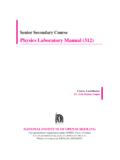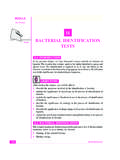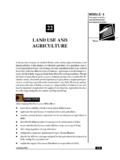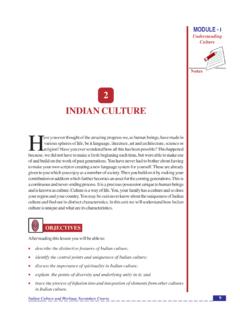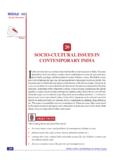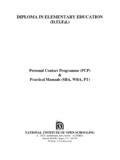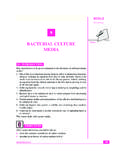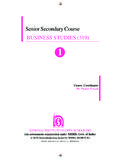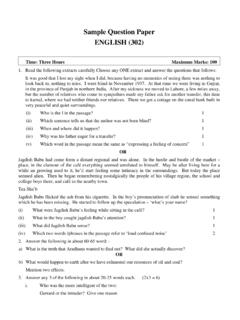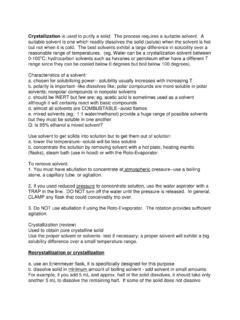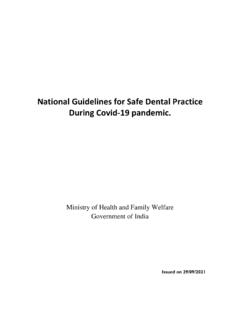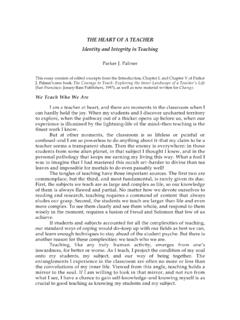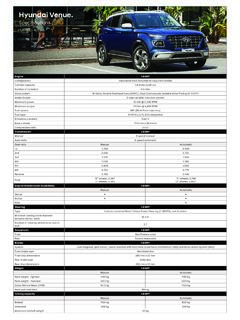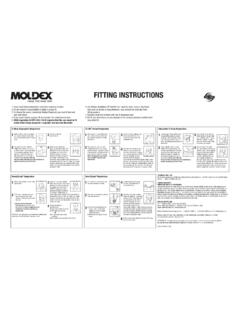Transcription of LABORATORY SAFETY AND Notes STANDARDS …
1 67 LABORATORY SAFETY and STANDARDS PrecautionsMICROBIOLOGYMODULEM icrobiologyNotes6 LABORATORY SAFETY ANDSTANDARDS INTRODUCTIONW orking in a LABORATORY usually involves working with various chemical,physical, and biological hazards. Because the hazards vary from LABORATORY tolaboratory, employers must address the hazards specific to their precautions are meant to reduce the risk of transmission of blood borneand other pathogens from both recognized and unrecognized sources. They arethe basic level of infection control precautions which are to be used, as aminimum, in the health care reading this lesson, you will be able tozdescribe preparing the laboratoryzexplain about common symbols used in laboratorieszexplain fire SAFETY and prevent fire accidents in the laboratorieszdescribe and follow equipment safetyzexplain and follow universal standard PREPARING FOR LABORATORY WORKB efore starting to work in a LABORATORY , you must familiarize with the following:zThe hazards of the materials in the lab, as well as appropriate safe handling,storage and emergency protocols.
2 Read labels and material SAFETY dataMICROBIOLOGYMODULEL aboratory SAFETY and STANDARDS PrecautionsMicrobiology 68 Notessheets (MSDSs) before moving, handling or opening chemicals. Never usea product from an unlabeled container, and report missing labels to agents, processes and equipment in the LABORATORY . If you are unsureof any aspect of a procedure, check with your supervisor before location and operation of SAFETY and emergency equipment such as fireextinguishers, eye wash and shower, first aid and spill response kits, firealarm pull stations, telephone and emergency exitszEmergency spill response procedures for the materials you will handleDuring LABORATORY workzRestrict LABORATORY access to authorized persons only.
3 Children are notpermitted in ; eating; drinking; storing food, beverages or tobacco; handlingcontact lenses are not permitted in lab coats (knee length) and SAFETY glasses in laboratories employingchemicals, biohazards or radioisotopes. Open shoes, such as sandals, shouldnever be worn in the work places clean and free of unwanted chemicals, biologicalspecimens, Avoid leaving reagent bottles, empty or full, on the only with materials once you know their safe handling and pipette by mouth; use mechanical transfer exits and passageways clear at all that access to personal protective equipments are not accidents and dangerous incidents ( near-misses ) promptly to yoursupervisorzWash your hands thoroughly before leaving the procedures that liberate infectious bio-aerosols in a biologicalsafety cabinetzHandle all human blood and body fluids as if potentially up before leavingPerform a SAFETY check at the end of each experiment and before leaving the sure to.
4 ZTurn off gas, water, electricity, vacuum and compression lines and heatingapparatus 69 LABORATORY SAFETY and STANDARDS PrecautionsMICROBIOLOGYMODULEM icrobiologyNoteszReturn unused materials, equipment and apparatus to their proper storagelocationszDispose of all waste defective or damaged equipment immediately, and arrange to haveit repaired or replacedzDecontaminate any equipment or work areas that may have been in contactwith hazardous behind protective clothing (lab coats, gloves, etc.) when leaving SYMBOLS TO BE IDENTIFIED BY ALLLABORATORY TECHNICIANSMICROBIOLOGYMODULEL aboratory SAFETY and STANDARDS PrecautionsMicrobiology FIRE SAFETYL aboratory fires can by caused by bunsen burners, runaway chemical reactions,electrical heating units, failure of unattended or defective equipment, oroverloaded electrical circuits.
5 Familiarize yourself with the operation of the fireextinguishers and the location of pull stations, emergency exits and evacuationroutes where you work. In the event that the general alarm is sounded use theevacuation routes established for your area and follow the instructions of theEvacuation Monitors. Once outside of the building, move away from the doorsto enable others to fire triangleFire cannot occur without an ignition source, fuel and an oxidizing atmosphere(usually air), the three elements that comprise what is called the fire triangle :Fire will not be initiated if any one of these elements is absent, and will not besustained if one of these elements is removed. This concept is useful inunderstanding prevention and control of fires.
6 For example, the coexistence offlammable vapours and ignition sources should be avoided, but when flammablevapours cannot be controlled elimination of ignition sources is how to use the extinguisher in your lab, as there will be no time to readinstructions during an emergency. Attempt to fight small fires only, and only ifthere is an escape route behind you. Remember to have the extinguisherrecharged after every : Pull and twist the locking pin to break the : Aim low, and point the nozzle at the base of the : Squeeze the handle to release the extinguishing : Sweep from side to side until the fire is prepared to repeat the process if the fire breaks out again 71 LABORATORY SAFETY and STANDARDS GLASSWARE SAFETYUse a dustpan and brush, not your hands, to pick up broken glass .
7 Discard brokenglass in a rigid container separate from regular garbage and label it SafetyEvery effort should be made to prevent equipment from becoming reduce the likelihood of equipment malfunction that could result in leakage,spill or unnecessary generation of aerosolized pathogens:zReview the manufacturer s documentation. Keep for future and service equipment according to the manufacturer s that anyone who uses a specific instrument or piece of equipmentis properly trained in setup, use and cleaning of the that equipment leaving the LABORATORY for servicing or disposal isappropriately decontaminated. Complete a Certificate of glass and plastic centrifuge tubes for stresslines, hairline cracks andchipped rims before use.
8 Use unbreakable tubes whenever filling tubes to the caps or stoppers on centrifuge tubes. Avoid using lightweight materialssuch as aluminum foil as sealed centrifuge buckets ( SAFETY cups) or rotors that can be loaded andunloaded in a biological SAFETY cabinet. Decontaminate the outside of thecups or buckets before and after centrifugation. Inspect o-rings regularly andreplace if cracked or that the centrifuge is properly not open the lid during or immediately after operation, attempt to stopa spinning rotor by hand or with an object, or interfere with the interlocksafety supernatants carefully and avoid vigorous shaking when baths, water bathszNever use LABORATORY ovens for preparation of food for human consumptionzGlassware that has been rinsed with an organic solvent should be rinsedwith distilled water before it is placed in a drying SAFETY and STANDARDS PrecautionsMicrobiology UNIVERSAL / STANDARD PRECAUTIONSU niversal PrecautionsThese guidelines refer to the precautions.
9 Consistently used for all patientsregardless of their infection status and diagnosis. The main objective is toprevent exposure of staff and patients to blood and body t eat, drink, smoke or apply cosmetics (including lip balm).zDon t insert or remove contact t bite nails or chew on t mouth access to the LABORATORY to trained personnel all patients are infectious for HIV or other blood borne appropriate barrier precautions to prevent skin an mucous membraneexposure, including wearing gloves at all times and masks, goggles, gownsor aprons if there is a risk of splashes or droplet hands thoroughly and other skin surfaces after gloves are removedand immediately after any injuries to sharps such as needles and PrecautionsIn 1996, CDC developed a new system of standard precaution synthesizing thefeatures of universal precautions and body substance isolation.
10 Standardprecautions are used in the care of all patients and apply to blood, all body fluids,secretion and excretion except sweat regardless of whether they contain precautions are guidelines and procedures designed to reduce the riskof transmission of microorganisms from both recognized and unrecognizedsources of infection in healthcare Precautions IncludezHand washingzBarrier protectionzSafe handling of sharp itemszSafe handling of specimen (blood etc)zSafe handling of spillage of blood/body fluidzUse of disposable/ sterile items 73 LABORATORY SAFETY and STANDARDS PrecautionsMICROBIOLOGYMODULEM icrobiologyNotesHand WashingSingle most important method to limit cross transmission of nosocomialpathogensMultiple opportunities exist for HCW hand contamination by Direct patient careand Inanimate environmentThis is an ideal SAFETY precaution and gloves should not be regarded as asubstitute for hand General Patient Care (Hand Contamination)zWash hands thoroughly in running water with soap without missing anyarea.
